Official Name:
Canyon Diablo is the name of the post office nearest to Meteor Crater, in northern Arizona.
Location:
In a desert plain 15 kilometres southeast of Canyon Diablo, Arizona, USA.
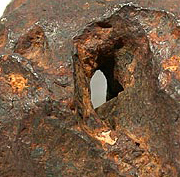
Enlargement
Canyon Diablo meteorite pierced by a cavity that previously held a graphite nodule. |
|
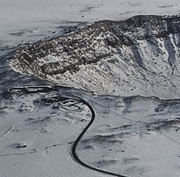
Enlargement
Sometimes, a fine layer of snow covers Meteor Crater. |
|
Fall or Find:
Find
Date:
The Canyon Diablo meteorite crashed to Earth between 20 000 and 50 000 years ago. At that time, there were no human populations in America to witness the impact. That is fortunate, because all life forms would have been wiped out for kilometres around!
Mass Recovered:
More than 30 metric tons of meteorite debris have been recovered over the last century. The mass of the fragments varies: some weigh only a few grams, while the largest weighs 454 kilograms.
Number of Fragments:
The Canyon Diablo meteoroid broke apart while travelling through the atmosphere. The main mass exploded when it hit the ground, increasing the number of fragments. The exact number of fragments that touched the ground and survived the impact is not known, but certainly is in the tens of thousands.
Strewn field:
The strewn field was completely disrupted by the formation of the crater. Meteorites were found up to 12 kilometres from the centre of the crater, with a high concentration in the first three kilometres.
Crater:
The impact structure formed by the Canyon Diablo meteoroid is called Meteor Crater or Barringer Crater. The crater is 1 280 metres in diameter and 180 metres deep. Under the effect of the impact, more than three hundred million tons of meteoritic rock and debris were hurled into the air.
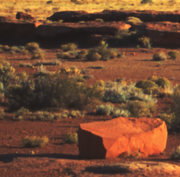
Enlargement
The mountains that form the rim of Meteor Crater are visible from a distance in the flat desert. |
|
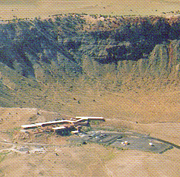
Enlargement
Aerial view of Meteor Crater and the nearby installations. |
|
Circumstances:
The first fragment was picked up by a shepherd named Mathias Armijo in 1886. Shortly thereafter, specimens from Canyon Diablo inundated the collectors' market. Today, pieces of this meteorite are found in almost all private and public collections in the world.
History:
Mining engineer Daniel Moreau Barringer was one of the first scientists to work on Meteor Crater. Exploring the crater for the first time in 1903, he was already convinced that a meteorite had created it. For the rest of his life, he tried to discover the huge iron meteorite he thought must be buried under the crater. He dug mine shafts and drilled exploratory drill holes. He intended to make a profit from this enormous mass of metal. His search was unsuccessful because most of the meteorite had been destroyed by the impact.
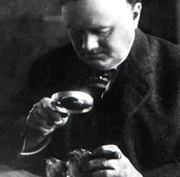
Enlargement
Daniel Moreau Barringer examining a Canyon Diablo meteorite. |
|
Type:
Iron meteorite
Class:
Coarse octahedrite, bandwidth 2 millimetres.
Group:
IAB
Composition:
The fragments collected at the rim of the crater and those collected in the surrounding plain have very different compositions. The meteorites from the circumference of the crater are twisted and their Widmanstätten patterns are absent or altered. These meteorites did not break off of the main mass during its entry into our atmosphere; rather they are what remained when the meteorite vaporized following impact. In some specimens, the shock of the impact transformed the graphite into diamond. Other pieces are pierced with cavities that once held graphite nodules, since altered by Earth's climate.
Canyon Diablo is composed mainly of iron mixed with 7.1% nickel, 1% carbon, 1% sulfur, 0.46% cobalt, 0.26% phosphorus, 320 parts per million germanium, 80 ppm gallium, and 1.9 ppm iridium.
Scientific contribution:
Originally identified as a volcanic structure, Meteor Crater was the first crater in the world recognized to have been created by a meteor. Thanks to the work of the many scientists who studied Meteor Crater, the idea that meteorite impacts could produce craters was finally accepted about 1950.
Comments:
The crater is definitely better known than the meteorite that created it. Meteor Crater is visited by more than 300 000 visitors each year. If you are on Interstate 40 in Arizona, get off at Exit 233 and take a look at the most well-preserved impact crater in the world.
Part of the Planétarium's collection:
Yes